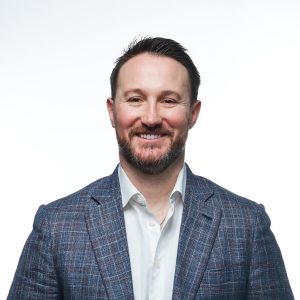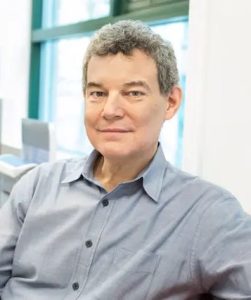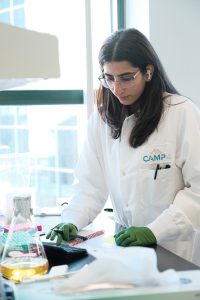
Several stories explain the name behind CAMP4 Therapeutics, a six-year-old developer of drugs based on targeting regulatory RNAs (regRNAs).
CAMP4 ties into the love of the outdoors shown by one of the company’s co-founders: Richard A. Young, PhD, a Core Member of MIT’s Whitehead Institute who, away from the lab, is a pilot who also enjoys hiking and mountain climbing.
CAMP4 also takes its name from two spots cherished by Young and other outdoors enthusiasts. One is the Camp 4 campsite in Yosemite Valley, within Yosemite National Park, where rock climbers have long come together to push themselves to the limit of what’s possible. Then there’s Camp IV on the South “Col” or pass at 26,000 feet (7,925 meters), just outside the “Death Zone” of Mount Everest.
“We think about CAMP4 like that, where we’re pushing the limits of what is possible for biology, to the benefit of patients,” CAMP4 President and CEO Josh Mandel-Brehm told GEN Edge. “We see disease as a mountain.”
Those proverbial mountains include central nervous system (CNS) disorders and liver diseases, though the company says its planned pipeline of RNA actuators has the potential to address a variety of genetic indications across multiple tissues. CAMP4 has lead programs in both disease categories, whose clinical development—as well as an expansion of its drug discovery platform—will be supported through proceeds of a recently concluded $100-million Series B financing.
“We’re excited to use the funding from this round to advance things towards and into the clinic, as well as expand the utility of the platform,” Mandel-Brehm said. “This is really a pivotal point for CAMP4, because it’s a moment where we can actually show the world the importance of these RNAs and how they can be used to make a whole new class of medicines.”
The latest financing brings to over $180 million the total capital raised by CAMP4, which is based in Cambridge, MA. CAMP4 occupies about 30,000 square feet of lab and office space at One Kendall Square, employing about 55 people.
That workforce is expected to grow by about 20 people over the coming year, Mandel-Brehm said, in roles designed to support new company infrastructure as well as support roles for executives that include two recent hires, Chief Medical Officer, Ann Barbier, MD, PhD, and a new head of manufacturing. CAMP4 will rely on third parties for manufacturing near term, but invest in its own manufacturing and/or pursue partnerships further in the future as several candidates enter the clinic.
In other appointments announced recently by CAMP4, Kelly Gold was promoted to Chief Financial Officer from Chief Business Officer and Senior Vice President of Finance; while Al Sandrock, MD, PhD, has been named to the company’s scientific advisory board. Sandrock is a former Executive Vice President of R&D at Biogen.
Platform and pipeline
CAMP4 specializes in treatments that target regRNAs, forms of RNA that regulate the expression of nearby protein-encoding genes and have not been explored as therapeutic targets. RegRNAs are within what scientists often call the “dark side” of the genome—the 98% of the human genome that does not encode proteins.
“These regulatory RNAs act as though they’re very precise rheostats to control the expression of nearby protein-coding genes,” Mandel-Brehm said. “We have discovered that we can actually take advantage of this phenomenon that exists in all of our cells and all of our tissues in our bodies by using antisense oligonucleotides, a form of RNA, to drug RNA. That allows us to precisely change the expression of our genes in a way that can have lasting effects over the course of a month, but not permanent effects. So, we can essentially control these regulatory RNAs to control the expression of protein coding genes.”
CAMP4’s RNA Actuating Platform (RAP™) is designed to map regRNAs associated with every protein-coding gene in any cell type, using next-generation sequencing technologies powered by proprietary AI algorithms. The company screens oligonucleotide drug candidates to target regRNA hotspots for maximum gene upregulation, using that data to design high-potency RNA Actuators designed to deliver treatments safely and effectively by targeting tissues that underlie disease.
The programmable antisense oligonucleotide (ASO) therapeutics developed through the platform target the controlling regRNAs to upregulate gene expression to treat disease. According to the company, RAP is the only platform specializing in the tunable upregulation of genes.

“The goal of the platform is that, for any gene you want to control, show me the sequence of all of the candidate regulatory RNAs. Then, we design sets of these small oligos, the actuators, test them ourselves, and find the ones that work and develop drugs out of those,” said David Bumcrot, PhD, CAMP4’s Chief Scientific Officer and Senior Vice President of Research.
“The oligos are binding these regulatory RNAs and controlling their function. They’re very drug like. They are only 20-25 nucleotides or letters long, as opposed to say messenger RNA, which can be 1,000 or more nucleotides long and has to be folded up inside a delivery vehicle.”
“These oligonucleotides that we use are very drug-like, particularly in the liver and in the CNS. They have very good distribution, cellular uptake, and a predictable dose response relationship. A drug can be given, you stop giving it or you give more, tuning its expression like a traditional drug,” Bumcrot added. “That’s in contrast to things like gene therapy or large RNA delivery approaches, where I think that is much more difficult to achieve.”
Broadly applicable
The company says its approach can be broadly apply to a variety of genetic diseases in which tunable increases in gene output can lead to meaningful therapeutic outcomes.
“There’s an entire category of disease—hundreds, maybe even thousands of diseases—that have a genetic basis whereby you are missing a protein and you’re not completely at a zero point,” Mandel-Brehm said. “We are using our platform that is the combination of these regulatory RNAs that only we can identify with antisense oligonucleotide chemistry, to essentially go after the entire category of these genetic diseases where you’re missing a little protein. And we’re taking advantage of your remaining healthy genes to make more protein.”
Furthest along in the company’s pipeline is its IND-enabling-phase treatment for Dravet Syndrome, designed to eliminate seizures or reduce their frequency and severity—as well as preserve neurodevelopmental milestones—by upregulating endogenous sodium channel α1 subunit (SCN1A) genes. CAMP4 expects the Dravet syndrome treatment to enter the clinic in mid-2023.
CAMP4 reasons that 80% of Dravet patients have mutations in the SCN1A gene, resulting in decreased expression of a sodium channel that impacts electrical activity leading to predisposition to seizures. Current treatments are anti-epileptics that are not specific to SCN1A, and the size of the gene (6,030 base pairs) makes it incompatible with traditional gene therapy delivery approaches.
Dravet syndrome is an example of a class of diseases for which CAMP4’s regRNA-targeting therapeutics are ideally suited, namely haploinsufficiency disorders caused by the loss of function of one of two copies of a gene, reducing by up to 50% normal protein levels. The company says its therapies can bring back near-normal protein levels by upregulating gene expression, doubling protein production.
“You have half as much of the protein as you need,” Bumcrot explained. “You don’t need to even increase expression all the way back to the normal level. Somewhere in between that 50% and the full expression—even if you only increase expression of that remaining good gene 25% or 30%—that will have a real impact.”
Real impact
Another disease category suited for CAMP4’s therapies is recessive (loss-of-function) diseases marked by up to 25% of normal protein production, as genetic mutations damage both gene copies. By upregulating expression of the mutated genes or a compensatory gene, CAMP4 says, it can restore or compensate for sufficient protein expression.

The treatment is one of two in CAMP4’s pipeline designed to treat UCD, which classically occurs in newborn babies, causing a 24% mortality rate. The company is also developing a UCD treatment designed to address all enzyme deficiencies by upregulating production of a rate limiting specific protein involved in urea cycle.
CAMP4 says it believes its approach to treating UCD will not only modify the disease but can be titrated, which will prove especially important as children with the disease grow.
Also in CAMP4’s pipeline:
- PBC: A discovery phase treatment for primary biliary cholangitis (PBC) designed to increase efflux of bile acids from the liver by upregulating an endogenous transporter, an approach CAMP4 says will decrease liver cell damage and normalizing the liver function.
- FTD-GRN: A preclinical treatment for frontotemporal dementia (FTD) caused by mutations in the progranulin gene (GRN), designed to upregulate the GRN mRNA in both neurons and microglia, in order to restore normal levels of progranulin.
“Simply by elevating the amount of progranulin in two cell types, both of which we can hit in the brain—neurons and microglia—we can address that disease [FTD],” Bumcrot said. “We’re starting with the genetic basis because we think that is a higher probability of success. We are completely confident if we can change the expression of the underlying genetic base of the single gene for that disease, we will have a meaningful outcome.”
CAMP4 says its potential avenues of pipeline expansion include heart diseases and muscle disorders.
“There are companies that are working on delivery of oligos to muscle and different tissues. We would be eager to work with some of these companies,” Bumcrot said. “We’re also starting to develop some of our own approaches, adding linkers to the nucleotides, and testing ligands. We really want to take advantage of all that’s going on out there in unlocking delivery to other tissues.”
Clinical phases
CAMP4 is among companies focused on increasing gene expression through noncoding RNAs. Two such companies have candidates in clinical phases.
Furthest along is MiNA Therapeutics, whose lead candidate MTL-CEBPA in combination with sorafenib (marketed by Bayer as Nexavar®) is under study in the Phase II OUTREACH-2 trial (NCT04710641), which dosed its first patient in January and is designed to recruit 150 patients. MTL-CEBPA/sorafenib is a small activating RNA (saRNA) designed to treat hepatocellular carcinoma (HCC) by targeting the CEBPA gene.
Also in the clinic is Stoke Therapeutics’ lead candidate STK-001, an ASO targeting SCN1A transcripts that is also being developed for Dravet syndrome. STK-001 is designed to upregulate NaV1.1 protein expression by leveraging the non-mutant “wild-type” copy of the SCN1A gene to restore physiological NaV1.1 levels. Stoke has said it plans to read out data from patients receiving multiple 30 mg doses later this year.
STK-001 is in a pair of Phase I/IIa studies, MONARCH in the U.S. (NCT04442295) and ADMIRAL in the U.K., as well as their respective open-label extension studies, SWALLOWTAIL (NCT04740476), which showed favorable safety data last year, and LONGWING (ISRCTN12811235).
Dravet is also the indication for OPKO Health’s OPK88001 (formerly CUR-1916), a small RNA candidate targeting the mutated SCN1A gene and developed through the company’s anti-Natural Antisense Transcripts (AntagoNAT) platform.
OPK88001 is a preclinical candidate, as are two gene-targeting saRNAs being developed by Ractigen Therapeutics: RAG-01, designed to treat non-muscle invasive bladder cancer byrestoring expression of the tumor suppressor gene p21 via RNA activation (RNAa); and RAG-06, designed to treat spinal muscular atrophy by targeting SMN2.
In January, Ractigen completed a $30-million “Series A+” financing, with the proceeds intended for advancing several programs into clinical phases and scaling up its oligonucleotide manufacturing capabilities. China’s state-owned investment arm State Development & Investment Corp. (SDIC) led the financing, with participation by Eisai, LC Ventures, CSSD Capital, and Xianghe Capital. Ractigen raised a $30 million Series A round in February 2021.
CAMP4 was founded in 2016 by Young of the Whitehead Institute and Leonard I. Zon, MD, Director of the Stem Cell Program at Boston Children’s Hospital and an Investigator with the Howard Hughes Medical Institute.
A year later, they brought Mandel-Brehm and Bumcrot on board. Bumcrot was director of research (2002-12) at Alnylam Therapeutics, which in 2018 received the FDA’s first approval for a small interfering ribonucleic acid (siRNA) treatment, Onpattro® (patisiran) for polyneuropathy caused by hereditary transthyretin-mediated amyloidosis (hATTR) in adults. After a year heading the RNA therapeutics lab at MIT’s Koch Institute for Integrative Cancer Research, Bumcrot became one of the first half-dozen employees to join Editas Medicine, where he served as senior director, molecular and cell biology, before joining then-stealth CAMP4 in 2017 as senior VP, head of biology. He was promoted to his current position three years later.
One more company
“When I heard about this other way of controlling genes, a whole new technology, I said, ‘Well, I guess I should have at least one more company in me. So I came back and joined this company,” Bumcrot recalled.
Mandel-Brehm, a founder and board member of Vico Therapeutics, held business development roles at Sanofi Genzyme and later at Biogen before joining CAMP4.
“It felt like an opportunity to learn, but also build something really important that can make a difference for people suffering from disease,” Mandel-Brehm said. “As a CEO, I’m learning every week from my colleagues, from my board members from my own mistakes. But it really does start honestly with the science and the people, and we will we always return to that here.”
CAMP4 emerged from stealth mode in 2018, raising $30 million in Series A financing, and completed a $45 million financing last year.
In between, CAMP4 collected $15 million in upfront capital from Biogen in an up-to-$284 million collaboration to address neurodegenerative and neurological diseases by identifying how to dial up or down the expression of disease-associated genes within microglial cells. CAMP4 also racked up an undisclosed amount of upfront cash in a research collaboration with Alnylam Pharmaceuticals to identify new druggable targets to address an undisclosed “rare disease of the liver with a significant unmet need.”
The Biogen and Alnylam partnerships have since ended, as CAMP4 evolved its focus from signaling pathways to regRNAs.
CAMP4’s latest Series B financing was led by Enavate Sciences, a portfolio company created by Patient Square Capital. Enavate’s CEO James Boylan has joined CAMP4’s board in conjunction with the financing.
Additional investors included a “large national managed care organization” and Gaingels, a syndicate of LGBTQIA+ investors and their allies, who have committed to advancing diversity of leadership through venture capital investment. “We pledged to have an open mind and be inclusive, whether it’s on the board or within the company, and to try and create opportunities for other underrepresented people or minorities. That’s something we take seriously, and we’re happy to do it,” Mandel-Brehm said.
Also joining the Series B were several new investors as well as earlier investors including 5AM Ventures, Polaris Partners, Northpond Ventures, Andreessen Horowitz, and The Kraft Group.
“It was 4-6 months to bring this all together,” Mandel-Brehm says. “This market is no longer a transactional market. People are paying close attention, not just at the science, but the teams. I think that’s a great thing. The people coming into this company spent time with us and understood what we’ve accomplished in the past on our track record. That’s why I feel really good about the investors coming in, as well.”
In conjunction with the financing, Boylan will join CAMP4’s Board of Directors.
“We see immense opportunity and value in CAMP4’s truly unique approach of upregulating gene expression using antisense oligonucleotides,” Boylan said in a statement. “Groundbreaking insights into regRNAs, powered by internally-derived machine learning algorithms, and our ability to drug targets with ASOs have merged together in CAMP4’s proprietary platform to advance an entirely new class of medicines. We’re excited to lead this financing and partner with CAMP4 to help realize the full potential of RNA actuators for patients with genetic diseases.”

